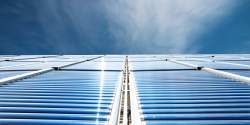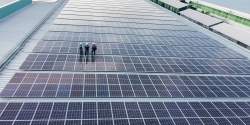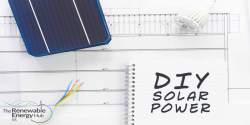Read Time : 3 Minutes
Monocrystalline Solar Panels
Monocrystalline solar cells are the most popular option on the market, as well as the most efficient form of solar cell. While they also tend to be the more expensive option, with monocrystalline cells you are guaranteed decent levels of efficiency in all weather conditions, making them a great option. Here is some further information on these solar panels, helping you to decide which are best for you.
Monocrystalline Solar Cells
These solar cells are also referred to as single crystalline cells. They are easily identifiable by their deep black colour and cut edges. Monocrystalline solar cells are also made from a very pure form of silicon, making them the most efficient material when it comes to the conversion of sunlight into energy. Additionally, monocrystalline solar cells are also the most space-efficient form of silicon solar cell. In fact, they take up the least space of any solar panel technology that is currently on the market.
They also have the great advantage of being the longest lasting solar cell technology, with their life expectancy currently set at around half a century. As a result of this, you will find that the majority of manufacturers will offer you warranties of up to 25 years on these solar panels, lasting half of their expected lifetime. While this system does remain superior in practically every way when compared to alternative models, it does come with a hefty price tag.
Monocrystalline solar cells are considered to be the most expensive option out of all the solar cell types. This is mainly due to the fact that each of the four sides is cut, which results in quite a large amount of waste. This is why polycrystalline acts as a cheaper alternative.
COMPARE PRICES FROM LOCAL INSTALLERS
Compare prices from local companies fast & free
Enter your postcode to compare quotes from leading professionals. We promise to keep your information Safe & Secure. Privacy Policy
The Pros and Cons of Monocrystalline Solar Panels
While they are the most efficient solar cell on the market, there are several advantages and disadvantages that come with monocrystalline solar panels, each of which is listed below. Here are some of the advantages of monocrystalline solar cells:
- They have the highest level of efficiency at 15-20%
- They require less space compared to other types due to their high efficiency
- Manufacturers state that this form of solar cell lasts the longest, with most giving them a 25-year warranty
- They perform better in low levels of sunlight, making them ideal for cloudy areas
Here are some of the disadvantages to monocrystalline solar cells:
- They are the most expensive solar cells on the market, and so not in everyone’s price range
- The performance levels tend to suffer from an increase in temperature. However, it is a small loss when compared to other forms of solar cell
- There is a lot of waste material when the silicon is cut during manufacture
How Much Do Solar Cells Cost?
When you do go to compare solar panel prices, you tend to be looking at the price for the entire solar panel system. The total cost will tend to vary according to the size and amount of panels that need to be installed on your home. The same applies to the power level of the panels as well as the method of installation. When it comes to estimating the costs, it is never a simple task as there are so many factors that can influence it.
However, a rough guide price puts a full solar panel system at between £3,000 and £5,000, as well as some additional costs that would be given to you at the time of the quote. While it may seem like a large amount, it is important that you don’t isolate the cost when you have so many benefits to consider. As a further point, it should be noted that the price of solar cells has continued to drop dramatically over recent years. This is because solar panels and renewable energy are becoming so much more popular among the public. In fact, solar power is already 99% cheaper to install and buy than it was in 1979, which is really quite impressive.
It is also possible to benefit from government schemes. One of these allows you to have the solar panels installed for free under the condition that you are essentially renting your roof out to the government. This is great if you don’t have the money for the upfront costs, but it does also mean that you cannot benefit from the Feed-in Tariff. This is where you are paid for the generation of electricity via your solar panels, allowing you to make a return (and even profit) on the cost of purchase and installation of your solar panels.
Want to Know More?
Have you found yourself interested in solar panels? If you want to know more then make sure you head to our marketplace where you can find our full range of products, each with the relevant information. Or simply give us a ring using the number at the top of this page and have a chat.





 How Much do Solar Panel Systems Cost in 2024?
How Much do Solar Panel Systems Cost in 2024?








Find a local installer
Welcome to the biggest directory of UK renewable energy companies